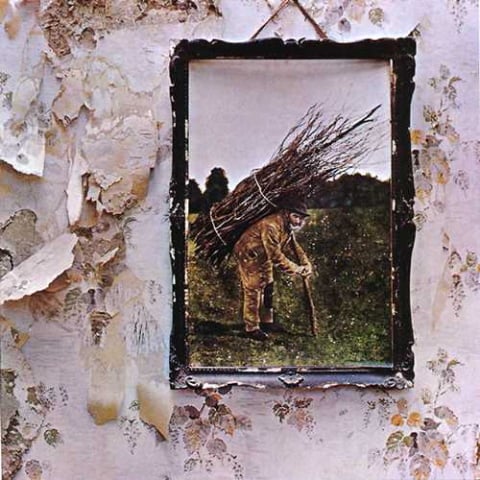An album cannot live by chart strength alone, and neither should you. It spent four weeks at #2. Good, but hardly worthy of consideration of sniffing the Top 100. One must go deeper. 14 weeks inside the Top 10, again; just an average to very good album by those statistics. How about 259 weeks on the chart? Now we're getting somewhere. Any album that spends nearly five years as a best-seller is going to be in the Top 100, no question. Then you add in airplay. How about one of the top songs in the Rock Era, one of the most Underrated (meaning not released as a single but another of the great rock & roll songs of the last 50 + years), and a whole album full of great tracks? Now we're talking upper echelon, aren't we?
A rather quick progression from an average album going just by chart numbers. But it is evidence of what needs to be looked at in considering the Top Albums of All-Time. And that is not to say that an album that was #1 for 15 weeks doesn't deserve it too, for that too has a lot going for it. It does say that you need to look at an abundance of factors, something that most album rankings do not do. This one does; I devised the computer formula that makes sure all of these factors are strongly considered.
Then you look at sales and IV by Led Zeppelin, or Four Symbols as it is sometimes known, sold a whopping 23 million. Now we're definitely Top 10 from the factors mentioned so far. Anyone that doesn't have it in the Top 10, sorry to say, is clueless. Then you consider what I call Track Rating*, and granted it is my professional opinion of the average track on the album, but a 9.25 is yet another feather in Led Zeppelin's cap. With all that, Led Zep fans may say, why isn't it #1? OK, you need to go back to the beginning. Four weeks at #2? The album wasn't even the top album of its time, it's quite a stretch then isn't it, to rank it #1 for all-time. Plus, you will see all that the Top Four* have going for them. If you're really objective, you'll see that IV ranks exactly where it should rank.

Besides forever being in listener's minds, IV is where "Stairway to Heaven" lives. That alone is a reason to own it, but you also get "Rock and Roll". "Black Dog" kick-starts the album from the beginning, and as I showed in the album review several months back, the mythic influences of J.R. Tolkien and others on Robert Plant began to show on this album. "The Battle of Evermore" and "Going to California" are both excellent tracks but you have to know that being #5 All-Time pretty much tells you that the entire album can be tracked through and there isn't even an average song on it.
Worldwide, IV has sold over 32 million, which could possibly rank it higher when we reveal The Top 100 Albums in the World*. I hope to finish that by September or so. The album received recognition when it was given a Grammy Hall of Fame Award in 1999.
The symbols referred to were merely a symbol that each of the four members of Led Zeppelin used. The album cover represented a conscious statement by the group that with all of the farms and countryside being torn down, we should look after the earth and not rape and pillage it. The cover was one of ten chosen by the Royal Mail in England for its "Classic Album Cover" postage stamps in January of 2010. The inside illustration, entitled "The Hermit" by Barrington Colby MOM, was influenced by the card that is included in the Rider-Waite tarot deck. . If one holds the inside cover of the album vertically up to a mirror (and of course you can't get this from a CD), you can see a man's face hidden in the rocks below the hermit. Some think that the face is actually that of a black dog.
IV:
Side one
1. "Black Dog" (Jimmy Page, Robert Plant, John Paul Jones) --4:54
2. "Rock and Roll" (Page, Plant, Jones, John Bonham) --3:40
3. "The Battle of Evermore" (Page, Plant) --5:51
4. "Stairway to Heaven" (Page, Plant) --8:00
Side two
5. "Misty Mountain Hop" (Page, Plant Jones) --4:38
6. "Four Sticks" (Page, Plant) --4:44
7. "Going to California" (Page, Plant) --3:31
8. "When the Levee Breaks" (Memphis Minnie, Page, Plant, Jones, Bonham) --7:07
Led Zeppelin was and will always be: The great Jimmy Page on acoustic and electric guitar and mandolin, lead vocalist Robert Plant (also playing harmonica), bassist John Paul Jones, who also played synthesizer, keyboards, mandolin and recorders and drummer John Bonham. Sandy Denny was brought in for vocals on "The Battle of Evermore" and Ian Stewart played piano on "Rock and Roll". Other than that, it's all Led Zeppelin.
Led Zeppelin started out recording IV at Basing Street Studios in London in December, 1970. With the suggestion of Fleetwood Mac, Zeppelin moved to HeadleyChkiantz also helping mix it and Joe Sidore mastering the CD. Graphreaks provided design coordination. The album was released November 8, 1971 on Atlantic Records.
And history was made. Led Zeppelin IV ranks as the #5 Album of the Rock Era*.

No comments:
Post a Comment
Note: Only a member of this blog may post a comment.